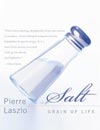Salt Notes : Ecological Impact
To produce salt by boiling brine requires 1.5 ton of wood per ton of salt.
The heath around Lüneburg, in Northern Germany, results from
deforestation to fulfill the needs of the Lüneburg salerns.
Læsø island (Denmark): Salt production was occurring in the fifteenth
century already. The canons of the distant Viborg cathedral negotiated a
salt tax in 1597. Production of salt on that island was discontinued in 1652,
there were no longer any trees for burning on the island.

